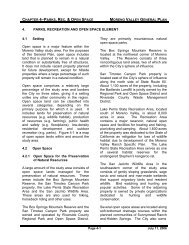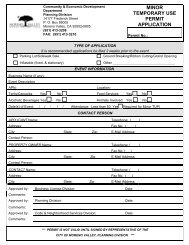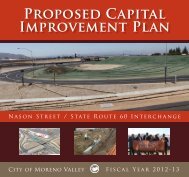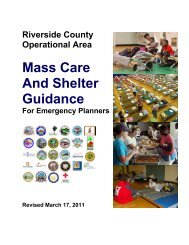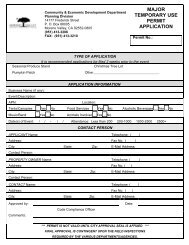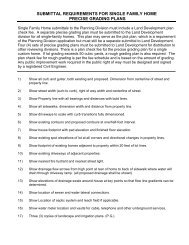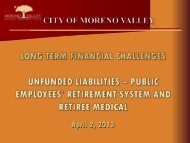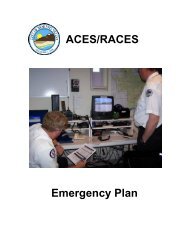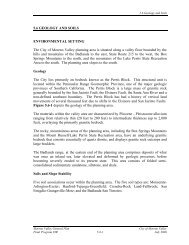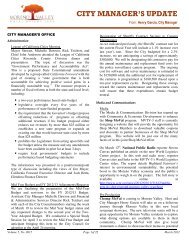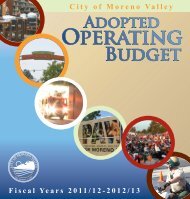General Plan - Moreno Valley
General Plan - Moreno Valley
General Plan - Moreno Valley
You also want an ePaper? Increase the reach of your titles
YUMPU automatically turns print PDFs into web optimized ePapers that Google loves.
CHAPTER 7 - CONSERVATIONThe EMWD’s 2000 Urban WaterManagement <strong>Plan</strong> predicts that supplies willmeet demand through the year 2010 evenunder worst-case conditions. Supplyreliability after 2010 depends on the outcomeof the CAL-FED process, a collaborativeeffort of multiple state and federal agenciesto resolve conflicts between urban,agricultural and environmental waterinterests. The goal is ensure that there willbe a reliable long-term supply of water forCalifornia.The Urban Water Management <strong>Plan</strong>contains the following statement on Page 19regarding future water supply: “based on theregional progress to date in developing offstreamstorage for surplus imported water,coupled with the local plans for resourcedevelopment, the District is confident of itsability to meet the water demands of itscustomers through 2020.”7.6 ENERGY RESOURCES7.6.1 BackgroundModern society depends on energyresources, including electricity, natural gasand other types of fuel. Energy is used fortransportation, heating, cooling, lighting andmanufacturing purposes. Continueddevelopment within the study area and thenation will consume additional energyresources.<strong>Moreno</strong> <strong>Valley</strong> is dependent on outsidesources of energy, including electricity andfossil fuels. State and federal institutionsand the private sector are responsible forthe supply and price of electricity. Electricityused within the study area is generated inthe region and at distant locations in thewestern United States. Electricity is derivedfrom nonrenewable fossil fuels, such asnatural gas, renewable wind energy andwaterpower, and other sources. The Cityand Southern California Edison distributeelectricity within the planning area.MORENO VALLEY GENERAL PLANThe State experienced a period of supplyunreliability and price volatility during 2000.The demand for electricity in Californiaexceeded the supply generated by powerplants within the state. The average price ofelectricity was among the highest in thenation.As with electricity, the City does not havedirect control over the supply of natural gasand gasoline. Natural gas is delivered to thearea from out of state sources. The nationalsupply of gasoline is derived from bothdomestic and foreign sources. Both naturalgas and gasoline are nonrenewable energysources, meaning that they cannot bereplenished.7.6.2. Issues and OpportunitiesIncreasing demands upon America’s supplyof energy has led to an increased relianceon foreign energy supplies and energy priceescalation. The use of energy resources isalso closely correlated with air quality.Air pollution is generated when fossil fuelsare burned to produce electricity. Emissionsare released when natural gas is used forspace heating and manufacturing. Motorvehicle emissions are the result of thecombustion of gasoline, diesel fuels andnatural gas.Energy conservation is a way to controlenergy costs, reduce reliance on foreignenergy supplies and minimize air pollution.Energy efficiency can be derived in thearrangement of land uses, in the design ofdevelopments and the architecture ofindividual buildings.The amount of energy consumed inautomobile travel can be reduced ifcommercial and recreational opportunitiesare located near residential uses.Commuter travel can be minimized if thereis a reasonable balance between jobs andhousing within the area. Placing highintensity uses along transit corridors canPage 7-10 July 11, 2006




